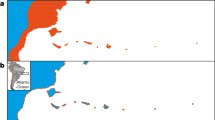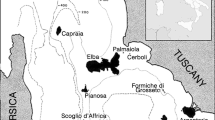Summary
Step-wise multiple regression was employed to probe the determinants of species diversity of day geckos (Phelsuma) in the Indian Ocean. Independent variables were area, elevation, and two measures of isolation. Distance from Madagascar and island height (an indicator of habitat diversity) were the two most important predictors of species richness. Similar studies on other taxa rarely find isolation to be a major factor. The relatively poor dispersal abilities of reptiles may explain why isolation, rather than attributes of the islands, are more important in this case. The regressions also indicate that habitat diversity (assumed to correlate with maximum island elevation) is more important than area per se in determining species diversity. These results agree with predictions of the equilibrium theory of island biogeography, but historical processes have also greatly influenced species richness.
Similar content being viewed by others
References
Abbott I (1974) Numbers of plant, insect, and land bird species on nineteen remote islands in the southern hemisphere. Oecologia 33:221–233
Adler GH, Wilson ML (1985) Small mammals on Massachusetts islands: the use of probability functions in clarifying biogeographic relationships. Oecologia 66:178–186
Amerson AB (1975) Species richness on the nondisturbed northwestern Hawaiian islands. Ecology 56:435–444
Arnold EN (1980) Recently extinct reptile populations from Mauritius and Reunion, Indian Ocean. J Zool 191:33–47
Blanc CP (1972) Les reptiles de Madagascar et des iles voisines. In: Battistini R, Richard-Vindard G (eds) Biogeography and ecology of Madagascar. Junk, The Hague, pp 501–611
Case TJ (1975) Species numbers, density compensation, and colonising ability of lizards on islands in the Gulf of California. Ecology 56:3–18
Case TJ (1983) The reptiles: ecology. In: Case TJ, Cody ML (eds) Island biogeography in the Sea of Cortez. University of California Press, Berkeley, pp 159–209
Cheke AS (1981) What the book does not tell you about day geckos: some comments on Oostveen'sPhelsumas, on new species and on recent research. Herptile 6(1):4–10
Cheke AS (1984) Lizards on the Seychelles. In: Stoddart DR (ed) Biogeography and ecology of the Seychelles Islands. Junk, The Hague, pp 331–360
Connor EF, McCoy ED (1979) The statistics and biology of the species-area relationship. Am Nat 113:791–833
Connor EF, Simberloff DS (1978) Species number and compositional similarity of the Galapagos flora and avifauna. Ecol Mon 48:219–248
Dewar RE (1984) Extinctions in Madagascar: the loss of the subfossil fauna. In: Martin PS, Klein RG (eds) Quaternary extinctions. University of Arizona Press, Tucson, pp 574–593
Diamond JM (1969) Avifaunal equilibria and specis turnover on the Channel Islands of California. Proc Natl Acad Sci USA 64:57–63
Diamond JM (1972) Biogeographic kinetics: estimation of relaxation times for avifaunas of Southwest Pacific islands. Proc Natl Acad Sci USA 69:3199–3203
Diamond JM, Mayr E (1976) The species-area relation for the birds of the Solomon Archipelago. Proc Natl Acad Sci USA 73:262–266
Durrell G (1977) Golden bats and pink pigeons. Wm. Collins and Sons, London
Fosberg FR (1971) Preliminary survey of Aldabra vegetation. Phil Trans R Soc Lond B 260:215–225
Gardner AS (1984) The evolutionary ecology and population systematics of day geckos (Phelsuma) in the Seychelles. PhD Dissertation, University of Aberdeen
Gilbert FS (1980) The equilibrium theory of island biogeography: factor or fiction? J Biogeog 7:209–235
Hamilton TH, Armstrong NE (1965) Environmental determination of insular variation in birds species abundance in the Gulf of Guinea. Nature 207:148–151
Hamilton TH, Rubinoff I (1967) On predicting insular variation in endemism and sympatry for the Darwin finches in the Galapagos Archipelago. Am Nat 101:161–171
Hamilton TH, Barth RH, Rubinoff I (1964) The environmental control of insular variation in bird species abundance. Proc Natl Acad Sci USA 52:132–140
Harris MP (1973) The Galapagos avifauna. Condor 75:265–278
Heatwole H (1975) Biogeography of reptiles on some of the islands and cays of eastern Papua-New Guinea. Atoll Res Bull 180:1–39
Johnson NK (1975) Controls of the number of bird species on montane islands in the Great Basin. Evolution 29:545–567
Jones KB, Kepner LP, Martin TE (1985) Species of reptiles occupying habitat islands in western Arizona: a deterministic assemblage. Oecologia 66:595–601
Kitchener DJ, Chapman A, Dell J, Muir BG (1980a) Lizard assemblage and reserve size and structure in the Western Australian wheatbelt — some implications for conservation. Biol Cons 17:25–62
Kitchener DJ, Chapman A, Muir BG, Palmer M (1980b) The conservation value for mamals of reserves in the Western Australian wheatbelt. Biol Cons 18:179–207
Kitchener DJ, How RA (1982) Lizard species in small mainland habitat islates and islands off south-western Western Australia. Aust Wildl Res 9:357–363
Lawlor T (1983) The mammals. In: Case TJ, Cody ML (eds) Island biogeography in the Sea of Cortez. University of California Press, Berkeley, pp 265–289
Loveridge A (1942) Revision of the afro-oriental geckos of the genusPhelsuma. Bull Mus Comp Zool 89:438–482
Lynch JF, Johnson NK (1974) Turnover and equilibria in insular avifaunas, with special reference to the California Channel Islands. Condor 76:370–384
MacArthur RH, Wilson EO (1967) An equilibrium theory of insular zoogeography. Evolution 17:373–387
MacArthur RH, Wilson EO (1963) The theory of island biogeography. Princeton University Press, Princeton, NJ
Mertens R (1962) Die Arten und Unterarten der GeckonengattungPhelsuma. Senck Biol 43:81–127
Mühlenberg M, Leipold D, Mader HJ, Steinhauer B (1977) Island ecology of arthropods. Oecologia 29:117–134
Murphy R (1983) The reptiles: origins and evolution. In: Case TJ, Cody ML (eds) Island biogeography in the Sea of Cortez. University of California Press, Berkeley, pp 130–158
Nussbaum RA (1984) Amphibians of the Seychelles. In: Stoddart DR (ed) Biogeography and ecology of the Seychelles Islands. Junk, The Hague, pp 379–415
Olson SL, James HF (1982) Fossil birds from the Hawaiian islands: evidence for wholesale extinction by man before western contact. Science 217:633–635
Osman RW (1978) The influence of seasonality and stability on the species equilibrium. Ecology 59:383–399
Peake JF (1971) The evolution of terrestrial faunas in the western Indian Ocean. Phil Trans R Soc Lond B 260:581–610
Power DM (1972) Numbers of bird species on the California islands. Evolution 26:451–463
Preston FW (1962) The canonical distribution of commonneess and rarity. Ecology 43:185–215, 410–432
Rey JR (1981) Ecological biogeography of arthropods onSpartina islands in northwest Florida. Ecol Mon 51:237–265
Rey JR (1984) Experimental tests of island biogeographic theory. In: Strong DR, Simberloff DS, Abele LG, Thistle AB (eds) Ecological communities: conceptual issues and the evidence. Princeton University Press, Princeton, NJ, pp 101–112
Russell AP (1977) The generaRhoptropus andPhelsuma (Reptilia: Gekkonidae) in southern Africa: a case of convergene and a reconsideration of the biogeography ofPhelsuma. Zool Afr 12:393–408
Schoener A, Schoener TW (1981) The dynamics of the species-area relation in marine fouling systems: 1. Biological correlates of changes in the species-area slope. Am Nat 118:339–360
Schoener TW, Schoener A (1983a) Distribution of vertebrates on some very small islands. I. Occurrence sequences of individual species. J Anim Ecol 52:209–235
Schoener TW, Schoener A (1983b) Distribution of vertebrates on some very small islands. II. Patterns in species number. J Anim Ecol 52:237–262
Schoener TW, Schoener A (1983c) The time to extinction of a colonizing propagule of lizards increases with island area. Nature 302:332–334
Simberloff DS (1972) Models in biogeography. In: Schopf TJM (ed) Models in paleobiology. Freeman, Cooper & Co., San Francisco, pp 160–191
Simberloff DS (1974) Equilibrium theory of island biogeography and ecology. Ann Rev Ecol Syst 5:161–182
Simberloff DS (1976) Experimental zoogeography of islands: effects of island size. Ecology 57:629–648
Steadman DW, Pregill GK, Olson SL (1984) Fossil vertebrates from Antigua, Lesser antilles: evidence for late Holocene human-caused extinction in the West Indies. Proc Natl Acad Sci USA 81:4448–4451
Stoddart DR (1967) Summary of the ecology of coral islands north of Madagascar (excluding Aldabra). Atoll Res Bull 118:53–61
Taylor JD, Braithwaite CJR, Peake JF, Arnold EN (1979) Terrestrial faunas and habitats of Aldabra during the late Pleistocene. Phil Trans R Soc Lond B 286:47–66
Toft CA, Schoener TW (1983) Abundance and diversity of orb spiders on 106 Bahamian islands: biogeography at an intermediate trophic level. Oikos 41:411–426
Vinson J, Vinson JM (1969) The saurian fauna of the Mascarene Islands. mauritius Inst Bull 6:203–320
Vinson JM (1976) The saurian fauna of the Mascarene Islands II. The distribution ofPhelsuma species in Mauritius. Mauritius Inst Bull 8:177–195
Vuilleumier F (1970) Insular biogeography in continental regions. I. The northern Andes of South America. Am Nat 104:373–388
Waide RB, Reagan DP (1983) Competition between West Indian anoles and birds. Am Nat 121:133–138
Whitehead DR, Jones CE (1969) Small islands and the equilibrium theory of insular biogeography. Evolution 23:171–179
Williams CB (1964) Patterns in the balance of nature and related problems in quantitative ecology. Academic Press, New York
Williams EE (1969) The ecology of colonization as seen in the zoogeography of anoline lizards on small islands. Q Rev Biol 44:345–389
Wright SJ (1979) Competition between insectivorous lizards and birds in Central Panama. Am Zool 19:1145–1156
Wright SJ (1981) Extinction mediated competition: theAnolis lizards and insectivorous birds of the West Indies. Am Nat 117:181–192
Author information
Authors and Affiliations
Rights and permissions
About this article
Cite this article
Losos, J.B. island biogeography of Day Geckos (Phelsuma) in the Indian Ocean. Oecologia 68, 338–343 (1986). https://doi.org/10.1007/BF01036735
Accepted:
Issue Date:
DOI: https://doi.org/10.1007/BF01036735




